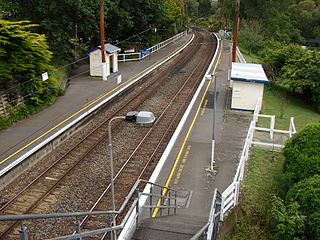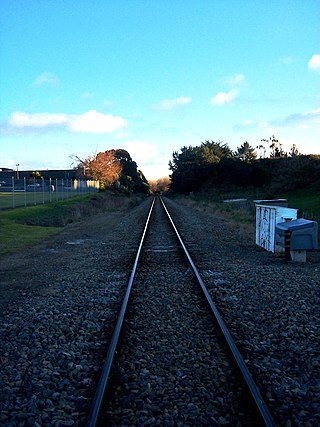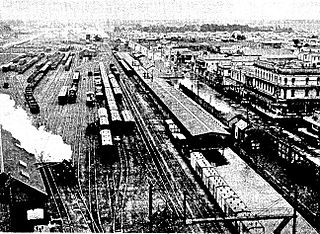
The Foxton Branch was a railway line in New Zealand. It began life as a tramway, reopened as a railway on 27 April 1876, and operated until 18 July 1959. At Himatangi there was a junction with the Sanson Tramway, a line operated by the Manawatu County Council that was never upgraded to the status of a railway.

The N class were 12 steam locomotives that operated on the national rail network of New Zealand. They were built in three batches, including one batch of two engines for the private Wellington and Manawatu Railway Company, the WMR, by the Baldwin Locomotive Works in 1885, 1891, and 1901. Previously the N class designation had been applied between 1877 and 1879 to Lady Mordaunt, a member of the B class of 1874.

The Wellington and Manawatu Railway Trust is a charitable trust based in Wellington, New Zealand, and is actively restoring former Wellington and Manawatu Railway locomotive No.9, to full working order.

The BC class comprised a single steam locomotive that operated on New Zealand's national rail network. Built for the Wellington and Manawatu Railway (WMR) and classified simply as No.17, it passed into the ownership of the New Zealand Railways Department (NZR) when the government purchased the WMR in December 1908, and it was then that it acquired the BC classification as BC 463.

The Napier Express was a passenger express train operated by the New Zealand Railways Department initially between Napier and Palmerston North and later between Napier and Wellington. It ran from 1891 until 1954.

The New Plymouth Express was a passenger express train operated by the New Zealand Railways Department (NZR) between Wellington and New Plymouth. It ran from 1886 until 1955 and was sometimes known as the New Plymouth Mail due to the Railway Travelling Post Office carriages included in its consist. The Express was notable amongst NZR's provincial expresses as being both the first and, until the commencement of the Gisborne Express in 1942, the longest in distance travelled.

The 8.38 miles (13.49 km) Tawa Flat deviation is a double-track section of the Kapiti Line just north of Wellington, New Zealand with two tunnels; the southernmost section of the North Island Main Trunk railway (NIMT) between Wellington and Auckland. It was built to bypass a limited capacity single track section of the original Wellington and Manawatu Railway (WMR) line which ascended from Wellington to Johnsonville and then descended to Tawa Flat. The original name of Tawa Flat was changed to Tawa in 1959.

Metlink's Kapiti Line is the electrified southern portion of the North Island Main Trunk railway between New Zealand's capital city, Wellington, and Waikanae on the Kāpiti Coast, operated by Transdev Wellington on behalf of Greater Wellington Regional Council. Trains run frequently every day, with stops at 16 stations. Until 20 February 2011 it was known as the Paraparaumu Line.
The Wellington and Manawatu Line is an unofficial name for the section of New Zealand's North Island Main Trunk Railway between Wellington and Palmerston North. Originally a government project, the line was constructed by the private Wellington and Manawatu Railway Company and bought by the government in December 1908.

Takapu Road railway station is on the suburban rail network of Wellington, New Zealand, on the Kapiti section of the North Island Main Trunk Railway (NIMT). It is double tracked with side platforms. It serves the suburbs of Redwood and Grenada North, and the rural Takapu Valley.
Linden railway station is located on the North Island Main Trunk Railway (NIMT) in Linden, New Zealand and is part of the suburban rail network of Wellington. It is double tracked, has an island platform layout, and is 14.91 km from Wellington railway station, the southern terminus of the NIMT.

Pukerua Bay railway station is located on the North Island Main Trunk Railway (NIMT) in Pukerua Bay, New Zealand and is part of the suburban rail network of Wellington. It is double tracked, has an island platform layout, and is 30.4 km from Wellington railway station, the southern terminus of the NIMT. It is one of two railway stations in Pukerua Bay, the other one at Muri being closed.

Otaihanga railway station was a flag station between Paraparaumu and Waikanae on the Wellington-Manawatu Line in New Zealand, when the line was run by the Wellington and Manawatu Railway Company. This line is now part of the Kapiti section of the North Island Main Trunk.

Thorndon railway station in Wellington, New Zealand, was opened in 1885 as the southern terminus of the Wellington and Manawatu Railway Company’s Wellington-Manawatu Line and then known as Wellington and Manawatu railway station. This line is now part of the Kapiti section of the North Island Main Trunk.

The NZR WH class was a class of three steam locomotives built by Manning Wardle in 1884 for service on New Zealand's private Wellington and Manawatu Railway Company (WMR). They did not acquire their WH classification until 1908 when WMR was nationalised and incorporated into the New Zealand Government Railways (NZR). A total of five locomotives were purchased by the WMR but two had been sold by the time NZR took over the company.

Shannon railway station is a station on the North Island Main Trunk serving Shannon in the Horowhenua District of New Zealand. It is served by the Capital Connection long distance commuter train between Wellington and Palmerston North.
The Haywards–Plimmerton Line was a railway development proposed several times between 1879 and the 1960s to connect the Hutt Valley and Porirua areas of Wellington via Haywards.

Longburn railway station was a station in Longburn, on the North Island Main Trunk in New Zealand. The platform, which is across from the Fonterra Factory, remains but the structure has been demolished.

Palmerston North Central railway station was a station on the North Island Main Trunk in New Zealand and the Palmerston North–Gisborne Line. The station opened in 1876 and closed in 1963.

The North–South Junction is a section of single-track rail line about 7 km long, north of Wellington, New Zealand between the closed (2011) Muri railway station and the (lower) Paekakariki railway station to the north. It is part of the Kapiti Line section of the North Island Main Trunk line between Wellington and Auckland, and part of the Wellington–Manawatu Line, built by the Wellington & Manawatu Railway Company (WMR).


















